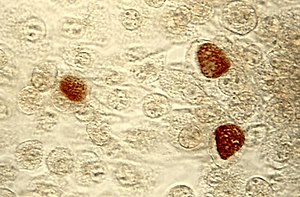Chlamydia trachomatis
| Chlamydia trachomatis | ||||||||||||
|---|---|---|---|---|---|---|---|---|---|---|---|---|

Chlamydia trachomatis inclusion bodies |
||||||||||||
| Systematics | ||||||||||||
|
||||||||||||
| Scientific name | ||||||||||||
| Chlamydia trachomatis | ||||||||||||
| ( Busacca 1935) Rake 1957 emend. Everett et al. 1999 |
Chlamydia trachomatis is an intracellular living gram-negative bacterium of the genus Chlamydia thatfeeds onthe cell's ATP as an energyparasite. With a size of 0.5 µm it is one of the smallest bacteria of all.
Serotypes
In tropical environments , C. trachomatis serotypes A, B and C excite trachoma , an eye infection and frequent cause of blindness .
Serotypes D-K, however, can acute conjunctivitis (pink eye, so-called. Swimming pool conjunctivitis , as transferable through bathwater), urethritis (mucosal inflammation of the urethra), epididymitis (of inflammation, proctitis rectum ), salpingitis (fallopian tube inflammation) and cervicitis cause (cervical inflammation) .
There are also serotypes L1, L2 and L3, which can cause lymphogranuloma venereum .
Chlamydia in the genitourinary tract
Chlamydia trachomatis can also cause a sexually transmitted disease in the genitourinary tract , two-thirds of which remains undetected in women, as it is symptom-free, occasionally causes urethral inflammation with clear discharge in men and is otherwise symptom-free. Chlamydial infections can be easily treated with antibiotics. An infection that is treated in good time usually does not result in any consequential damage. Untreated infections, however, can lead to infertility. According to estimates, more than 100,000 women in Germany today are involuntarily childless as a result of untreated chlamydia-related infections , since the pathogens, if the infection is not treated, persist in the fallopian tubes for years and can cause a chronic infection of the internal female genital organs.
Thesis of a connection with arteriosclerosis
Chlamydia was discovered in tissue samples from arteriosclerotic plaques. It is controversial whether Chlamydia pneumoniae causes arteriosclerosis, accelerates the course of the disease or is only an accompanying phenomenon. Further treatment with antibiotics for secondary prophylaxis is not definitely indicated.
therapy
Chlamydia infections can be easily treated with tetracyclines such as doxycycline , but also with erythromycin and other macrolide antibiotics . In addition, are also quinolone antibiotics successfully used ( levofloxacin , ciprofloxacin and a further developed moxifloxacin ). Grepafloxacin and sparfloxacin , which are no longer on the market in Germany, are quinolones that have been expanded to include chlamydia . The duration of treatment is usually 7 days. There is also the option of a so-called "single-dose" therapy with azithromycin . With regard to the order of choice, tetracyclines, macrolides, then quinolones, if applicable, can be seen. The therapy can only be successful in the long term if all sexual partners are also treated. In many cases there is also gonorrhea as a double infection , which can also be treated with the antibiotics mentioned .
For diagnosis see article chlamydia .
Reporting requirement
In Switzerland, the positive laboratory analytical finding for laboratories is notifiable and that after the Epidemics Act (EpG) in connection with the epidemic Regulation and Annex 3 of the Regulation of EDI on the reporting of observations of communicable diseases of man .
literature
- E. Gabler-Sandberger: Chlamydia in atheroma: be careful when interpreting. In: German Medical Weekly . 123 (6), 1998, p. A12.
- B. Lüderitz: Is coronary sclerosis an infectious disease? In: Deutsches Ärzteblatt. 18, 1997, pp. 950-951.
- R. Marre, A. Essig: Chlamydia pneumoniae and arteriosclerosis. In: German Medical Weekly. 122 (38), 1997, pp. 1092-1095.
- R. Marre, A. Essig: Diagnosis and therapy of chlamydial infections. In: German Medical Weekly. 122 (31/32), 1997, pp. 971-975.
- NN: The chain of clues is becoming increasingly dense. In: Deutsches Ärzteblatt. 18, 1997, pp. 944-946.
- S. Schattenfroh: The thesis is old, the pathogen is new: Arteriosclerosis an infectious disease? In: German Medical Weekly. 122 (16), 1997, pp. 7-8.
- S. Schattenfroh: On the trail of arteriosclerosis pathogens. In: German Medical Weekly. 122 (41), 1997, pp. A9-A10.
- W. Stille: Atherosclerosis - an infection by Chlamydia pneumoniae. In: German Medical Weekly. 122 (36), 1997, pp. 1086-1091.
- G. Wolfram: chlamydia and arteriosclerosis. In: . Nutritional review. 45 (1), 1998, pp. B1-B4.
- Marianne Abele-Horn: Antimicrobial Therapy. Decision support for the treatment and prophylaxis of infectious diseases. With the collaboration of Werner Heinz, Hartwig Klinker, Johann Schurz and August Stich, 2nd, revised and expanded edition. Peter Wiehl, Marburg 2009, ISBN 978-3-927219-14-4 , p. 189 f.
Web links
Chlamydia trachomatis. Robert Koch Institute, July 10, 2018.
Individual evidence
- ↑ WHO - Causes of blindness and visual impairment who.int ( Memento of the original from June 5, 2015 in the Internet Archive ) Info: The archive link was inserted automatically and has not yet been checked. Please check the original and archive link according to the instructions and then remove this notice.
- ↑ Chlamydia infection. on: netdoktor.at
- ^ Association for independent health advice (ed.): Can arteriosclerosis be triggered by an infection? (on-line)
- ↑ Erland Erdmann: Clinical cardiology: diseases of the heart, the circulation and the vessels. 6th edition. Springer, 2006 (online)